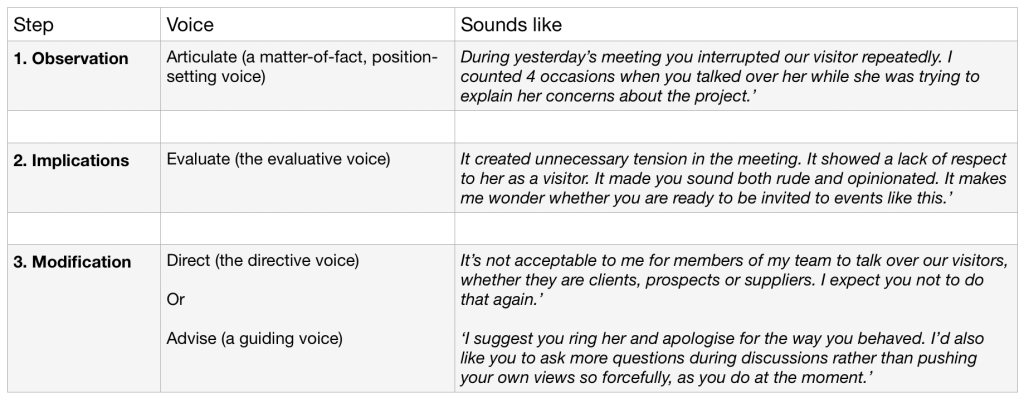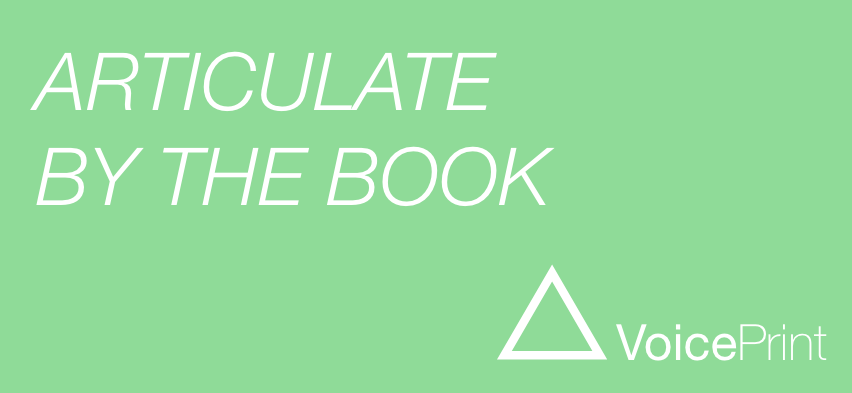
What does good feedback sound like? What voices, or ways of expressing yourself, do you need to enable feedback to be both critical and constructive? How can you give better feedback that’s likely to make a difference?
Let’s start with an example of how not to to do it.
I used to work with a manager called Jimmy and one day, glancing out of the window while we were in a meeting together, he suddenly said, ‘There’s MacTaggart arriving late again. I must have a word with him.’ That was on the Monday and the first thing that Jimmy got wrong was not giving his feedback promptly. I know that, because I was with him again on the Thursday, when he finally did. We were walking through the factory together to another meeting, when he suddenly peeled away and went over to the bench where the unsuspecting target of his feedback was working. ‘MacTaggart,’ said Jimmy sternly, ‘You’re getting a reputation.’ He accompanied his words with a slow, hard look. ‘Sort your act out.’
As we walked on, I looked back over my shoulder and in my mind’s eye I can still see the puzzled expression on the face of poor William MacTaggart. He was scratching his head in bewilderment. No doubt he was trying to figure out what had just been said. It was clearly something significant, but he was probably mystified as to what or why. It was also clear that he was expected to start doing something different. But he probably hadn’t a clue what that was either.
Jimmy had not delivered a great piece of feedback, although he probably thought he’d done what he needed to do. In fact, he’d managed to miss out all three of the crucial ingredients that are required to make a piece of critical feedback effective.
The 3 ingredients for good feedback, and the sequence in which to deliver them are:-
-
The Observation
-
The Implications
-
The Modification.
The Observation specifies the particular piece of behaviour to which the feedback refers.
‘You arrived late for work on Monday morning. That wasn’t the first time you’ve done that.’ Unless you ground your feedback in a specific episode or moment, the other person will find it hard even to recognise, far less accept, what you’re talking about. Just because an issue is at the front of your mind as needing to be said, there is no reason to suppose that it’s in the other person’s mind, far less near the front. So you need the Observation element, something you’ve witnessed the other person doing or saying, to establish the reality and credibility of anything else you go on to say. It provides your evidence and the foundation of your feedback.
The Implications are your means of explaining why your Observation matters.
For example, ‘Because you were late, we had to find someone else to do the job you were working on. The production process fell behind schedule. If we miss our despatch times, the customer complains and we can incur penalty charges for late delivery.’ The Implications spell out the substance of the criticism at the heart of the feedback. They explain the relevance of the observed behaviour, why it represents a shortcoming. (Incidentally, the same principles apply to giving congratulatory feedback. I’m illustrating this piece with critical feedback, because that’s the sort that people usually find harder to give as well as receive.)
I say ‘Implications’ plural rather than Implication, because there’s usually more than one consequence or repercussion as a result of any significant failing. Generally there is an impact on the task that the individual was expected to perform, on the process to which this task contributes, on the team or other people involved, and on the reputation or prospects for the persons concerned. This ingredient should leave the receiver of feedback with a new level of awareness and in no doubt about the consequences of their actions (or inactions).
The third step in good feedback is the Modification. This is where you suggest what the other person should do differently in future.
I say suggest, but you might simply tell. The directness of how you deliver this aspect of your feedback will depend on the nature of your relationship. If you are their manager, then you have not just the right but the responsibility to tell them what you expect and require. Most importantly, this is the ingredient which will make your feedback constructive. ‘If you find you’re going to be unavoidably late, then get a message to your supervisor beforehand and as soon as possible, so that alternative arrangement can be made promptly.’ If you can’t specify at least one modification, then you haven’t yet thought clearly enough about what does and does not constitute an acceptable level of performance. And if you can’t specify that, then your whole basis for being critical of others becomes shaky. The Modification element is your opportunity to be clear about standards.
Cast your eye back over my earlier story of what Jimmy said. You’ll see how he failed to provide either Observation, Implication or Modification.
Giving good critical feedback is not an inherently difficult thing to do, but of course it’s natural to feel uncomfortable or inhibited about doing it, because of the interpersonal risk involved. Part of the power of the Observation – Implications – Modification technique is that it reduces that risk by making the feedback not only more objective but also more digestible.
The other thing that helps is to be composed. I mean composed both in the sense of being calm and taking your time to deliver your words with care, so that they are clear and clearly heard, and also in the sense of having composed those words carefully beforehand. It actually doesn’t take long, if you use this framework to help you structure what you need to say. Try it.
One extra tip that is worth having is this. When preparing the three parts of your message, you may well find that it’s easier to get the basis of the Implications and the Modification than it is to recall the Observation which has prompted you to want to give the feedback in the first place. ‘I wish she wouldn’t keep doing X…’ or ‘If only I could get him to do Y…’ If it’s the foundations of why the behaviour matters or what you’d like to see being done differently that comes to mind first, that’s fine. Think those bits through, and as you do so, ask yourself what episode or behaviour has brought these things to the front of your mind. The sequence you use to construct your feedback does not need to be the same as the sequence you use to deliver it.
A little bit of preparation like this makes a big difference.
When it actually comes to giving your feedback, you’ll be composed and ready, and you can deliver each ingredient in turn and in the appropriate voice. So here’s the quick summary, identifying the voices you’ll need together with an example to illustrate and the essence of what they should sound like.

Use our feedback plan PDF next time you need to deliver feedback to organise and keep your feedback effective and constructive.
Get The Feedback Plan PDF
Oops! We could not locate your form.
Alan Robertson

Ready for a conversation?


